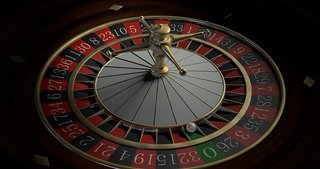Betting strategy for roulette

Peter has come up with a betting strategy for the roulette game, so he thinks he can always win in the end. He always bets on red, but adjusts the bet to whether he won or lost last. His strategy has two simple rules:
- If he won the last spin or the game is just starting, he only bets one dollar.
- If he has lost the last spin, he doubles the bet for the next spin.
Even if he loses a series of spins, eventually Peter will win. As he doubles the bet, he increases his potential profits so that he can compensate for his losses. Each series of losses ends with a win and a profit of one dollar. Peter plays roulette for an entire afternoon and can win a total of 100 dollar.
What happens in the long run? Does Peter's betting strategy actually work?
Details and Assumptions: For every spin of the roulette, the ball falls into one of the compartments with numbers from 0 to 36. In 18 out of 37 cases, this results in a red number. If you bet on the color red and win, you get the wager as the profit (money is doubled), otherwise the bank keeps the bet. Every number from 0 to 36 occurs with equal probability .
This section requires Javascript.
You are seeing this because something didn't load right. We suggest you, (a) try
refreshing the page, (b) enabling javascript if it is disabled on your browser and,
finally, (c)
loading the
non-javascript version of this page
. We're sorry about the hassle.
Peter's strategy only works if it has an infinite amount of capital. However, since his funds are finite, eventually comes the point, at which he can not double the bet and thus loses a large portion of his money.
The probability of winning a spin is p = 3 7 1 3 ≈ 4 8 . 6 5 % whereas the probability of losing gives q = 1 − p . We assume, that Peter has a monetary assets of x dollar from the beginning with x = $ ( 2 N − 1 ) = $ n = 0 ∑ N − 1 2 n This means that Peter would go bankrupt after a series of N lost spins with a probability of Q = q N (The profit in this case is equal to − x ) If he loses only a small series of k games with k < N , Peter's profit results to y = $ ( 2 k − n = 0 ∑ k − 1 2 n ) = $ 1 with a win probability P = 1 − q N . Therefore, the expected value for the profit yields E = y ⋅ P + ( − x ) ⋅ Q = $ ( 1 − ( 1 + x ) q N ) = $ ( 1 − 2 N q N ) < $ ( 1 − 2 N 2 N 1 ) = $ 0 since q > 2 1 . Thus, the expected value is negative and Peter will lose his money in the long run. The expectation value is even lower than for a single roulette spin with E 0 = ( $ 1 ) ⋅ p + ( − $ 1 ) ⋅ q = $ ( 1 − 2 q ) > $ ( 1 − ( 2 q ) N ) = E although you get the same profit of one dollar if you win. Paradoxically, the win probability P can be close to 100% for large numbers for N . Let's give a numeric example N x P E E 0 = 1 0 = $ 1 0 2 3 ≈ 9 9 . 8 7 % ≈ − $ 0 . 3 0 6 ≈ − $ 0 . 0 2 7 In this example, Peter loses an average of 31 cents when using his betting strategy, while losing only 3 cents for a single spin.